Personal Details
Born: 13th July 1891 in Stoke Newington, Middlesex, but not baptised until 1st April 1906 in Harpenden, Hertfordshire.
Family: He was the eldest of 3 children born to James Charles Beesley and his wife Sophia Honor (nee Runnicus). His father died in 1900 when Horace was 9. Horace married his first wife, Madeleine Apion, Quarter 4 1916 in Lewisham London. They had a daughter, Jean, who was born and died Quarter 4 1917 in Whitchurch, Shropshire. Madeleine died Quarter 1 1920 in Rochford, Essex. Horace married Josephine Rose Quarter 4 1922 in Kensington, London and together they had 2 children – Judith, born in 1923 and Symon Richard, born in 1927.
Residence: In 1901 he was living at Wheathampstead Road, Harpenden, Hertfordshire but by 1911 the family had moved to Tennyson Avenue in the same town. On the Absent Voters List for Whitchurch Shropshire, Spring 1919, his address was given as Holly Lodge, Salisbury Avenue. There is no Salisbury Avenue in Whitchurch, but there is a Salisbury Road. However, when he applied for his medals in 1923 the address given was Cheapside, London E.C.2. At the time of his death in 1961 he was living at 14 Mays Hill Road, Shortlands, Kent.
Employment: On the 1911 Census his occupation was a silk mercer.
Died: 7 January 1961, aged 69.
Military Details
Regiment: King’s Shropshire Light Infantry
Rank: Lieutenant, rising to the rank of Captain by 1918
Service Number:
Date of Enlistment: Not known
Date of Discharge: Not known
Reason for Discharge: Not known.
Other Information:
Horace was awarded the Campaign Medals (British War Medal, and Victory Medal).

The British War Medal (also known as 'Squeak') was a silver or bronze medal awarded to officers and men of the British and Imperial Forces who either entered a theatre of war or entered service overseas between 5th August 1914 and 11th November 1918 inclusive. This was later extended to services in Russia, Siberia and some other areas in 1919 and 1920. Approximately 6.5 million British War Medals were issued. Approximately 6.4 million of these were the silver versions of this medal. Around 110,000 of a bronze version were issued mainly to Chinese, Maltese and Indian Labour Corps. The front (obv or obverse) of the medal depicts the head of George V. The recipient's service number, rank, name and unit was impressed on the rim.
The Allied Victory Medal (also known as 'Wilfred') was issued by each of the allies. It was decided that each of the allies should each issue their own bronze victory medal with a similar design, similar equivalent wording and identical ribbon. The British medal was designed by W. McMillan. The front depicts a winged classical figure representing victory. Approximately 5.7 million victory medals were issued. Interestingly, eligibility for this medal was more restrictive and not everyone who received the British War Medal ('Squeak') also received the Victory Medal ('Wilfred'). However, in general, all recipients of 'Wilfred' also received 'Squeak' and all recipients of The 1914 Star or The 1914/1915 Star (also known as 'Pip') also received both 'Squeak' and 'Wilfred'. The recipient's service number, rank, name and unit was impressed on the rim.

